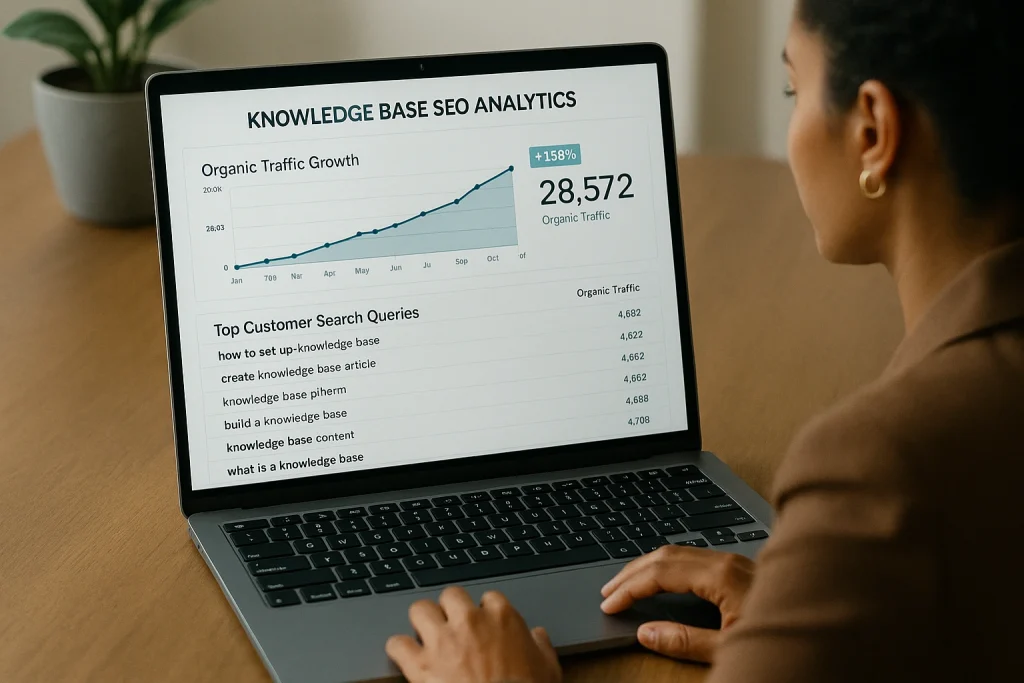You hit publish. You share the link on LinkedIn. You watch the real-time traffic spike and feel that little jolt of victory. But a week later, the numbers are flat. The comments are silent. Those visitors came, they saw, and they clicked away forever.
That isn’t an audience. It’s a sugar rush.
One-time readers are a sign of a deeper problem. Your content is getting found, but it isn’t connecting. It’s a transaction, not the start of a relationship. If you want them to stay, you have to give them a reason. It starts here.
The Hook: Stop Writing for Everyone, Start Writing for Someone.
The biggest mistake we see on company blogs is playing it safe. The content is technically correct, perfectly optimized, and completely forgettable. It has no pulse. Before you worry about newsletters or pop-ups, you have to fix the core product: your content. People don’t return to a library for one book. They return to a specific author for their voice.
The goal isn’t just to be a resource. It’s to become a reflex.
Develop a Real Point of View (No More Fence-Sitting)
Generic content gets generic results. If your article could be published on any of your competitors’ blogs with a simple logo swap, you’ve already lost. A point of view is what makes you memorable. It’s your take, your philosophy, your “hell no” to the industry’s “best practices.” This is what builds trust. In fact, 71% of consumers say it is more important than ever to trust the brands they buy from (Edelman, 2024).
- Example: A project management software company could write a post titled, “Why Daily Stand-Ups Are Killing Your Team’s Productivity.” It’s a bold, specific take that will attract defenders and detractors. It starts a conversation.
- Action: Get your team in a room. Whiteboard three common industry beliefs that you disagree with. That’s your starting point for content with a pulse.
Map Content to Their Problems, Not Your Product Features
Nobody wakes up hoping to read about your product’s latest update. They wake up with a problem that’s costing them time or money. Your content needs to meet them there. The single best source for this is your front lines: the sales and customer success teams. They hear the real, unfiltered questions every single day.
Turn those questions into your headlines.
- Example: An accounting software firm’s sales team keeps hearing, “We’re worried about messing up our first payroll tax filing.” The perfect blog post isn’t “Our New Payroll Module.” It’s “The 5 Most Common Payroll Tax Mistakes for New Businesses (and How to Avoid Them).”
- Action: Send a one-line email to your sales team: “What’s the one question you’re tired of answering?” You’ll get a week’s worth of killer content ideas.
Traffic is a transaction. An audience is an asset. The difference is a point of view.
Shift from One-Off Posts to Bingeable Series
One great post is a good start. A series of great posts is a habit. When you structure content episodically, you give readers a reason to come back. You’re telling a bigger story, and each post is a new chapter. This transforms your blog from a random collection of articles into a curated learning path. It signals to the reader that you have deep expertise, not just surface-level answers.
- Example: Instead of one giant “Ultimate Guide to SEO,” create a three-part series. Part 1: “Fixing the Foundation: A 10-Point Technical SEO Audit.” Part 2: “Finding Your Keywords: How to Target What Your Customers Actually Search For.” Part 3: “Beyond the Blog: Building Links That Matter.”
- Action: Look at your most popular blog post. What’s the logical next step for that reader? Write that post. Then tease it at the end of the original.
| Attribute | One-Off Post | Bingeable Series |
| Goal | Answer a single, specific question. | Own a broad topic and guide the reader. |
| Reader Expectation | Get in, get the answer, get out. | Invest time to build expertise. |
| Business Outcome | Ranks for a long-tail keyword. | Builds topical authority and audience trust. |
The Experience: Make Your Blog a Place They Want to Be.
Great content in a terrible package is still a terrible experience. If your site is slow, hard to read, or cluttered with annoying pop-ups, you’re creating friction. You’re making it hard for them to like you. Users form a first impression in milliseconds and, according to usability research, often leave a web page in 10-20 seconds (Nielsen Norman Group). You earned the click. Don’t lose their attention to a bad experience.
Your blog isn’t just a publication. It’s a product. Make it a pleasure to use.
Write Like a Human, Not a Corporate Robot
People connect with people. Corporate jargon, dense paragraphs, and buzzword-heavy sentences are reader repellent. Your voice should be as valuable as your insights. Read your drafts out loud. Does it sound like a person talking, or a press release?
- Example: Instead of, “Our synergistic solution leverages next-generation architecture to optimize user workflows,” try, “Our tool helps your team get projects done faster.” One is noise. The other is a promise.
- Action: Run your next draft through a free readability tool like Hemingway App. Aim for a Grade 8 reading level. Your readers will thank you.
Make Subscribing the Easiest Yes of Their Day
If a reader loves your content enough to subscribe, get out of their way. Every extra field you ask for, every confusing step, is a chance for them to abandon the process. Make your call to action clear, the benefit obvious, and the form ridiculously simple.
- Example: A simple, one-line call to action—”Get our best thinking in your inbox, every two weeks.”—with a single field for their email address is perfect. It’s a low-friction, high-value exchange.
- Action: Look at your blog’s subscribe form right now. Remove every field that isn’t absolutely essential. Hint: You probably only need their email.
Turn Your Comments Section into Your Unofficial Focus Group
The comments section isn’t a chore to be managed. It’s a gift. It’s where your most engaged readers give you free insights, ask clarifying questions that reveal content gaps, and tell you exactly what’s on their minds. Engaging here shows you’re listening and turns passive readers into a real community.
- Example: A reader leaves a thoughtful comment asking how the advice in your article applies to a specific niche. You provide a detailed answer and then realize it’s a perfect topic for a follow-up post.
- Action: For the next 30 days, commit to personally replying to every single relevant comment on your blog within 24 hours.
Your blog isn’t just a publication. It’s a product. And if it’s hard to use, people will stop using it.
The Return Trip: Build the Pathways That Bring Them Back.
Even the most impressed reader is busy. They have a dozen other tabs open and a to-do list a mile long. Hoping they remember to come back is not a strategy. You need to build intentional, reliable pathways that guide them back to your site. This is how you move from random visits to a predictable audience engine. For small and mid-sized businesses, email is a primary channel for this, with 80% using it for customer retention (Campaign Monitor, 2021).
Your Newsletter Is Your Direct Line, Not a Megaphone
A newsletter is the single best tool for driving repeat visits. But most companies get it wrong. They treat it like an RSS feed, a boring list of links. Don’t do that. Treat it like a personal update from the smartest person they know on the topic. Add context. Share a unique insight. Make the email itself valuable, not just the links in it.
- Example: Instead of a list of post titles, your newsletter could lead with a short, personal take from your CEO on a recent industry trend, which then tees up the articles you’re sharing.
- Action: In your next newsletter, write a one-paragraph intro that explains why these articles are important right now. Connect them to a current event or a common pain point.
Find Your Winners and Double Down (The Data Never Lies)
You don’t have to guess what your audience wants. They’re telling you with their clicks and their time. Your analytics are a roadmap to creating more of what works. A quick look at your data can reveal breakout topics, popular formats, and posts that are resonating far more than others.
- Example: You check your analytics and see an old post on “How to Calculate Customer Lifetime Value” gets consistent daily traffic. This is a clear signal to create more content around CLV, maybe a deeper dive, a case study, or a downloadable worksheet.
- Action: Open your analytics and find your top 5 most-viewed posts from the last 90 days. Brainstorm three follow-up topics for each one.
| Metric | What It Tells You | Where to Find It (GA4) |
| Returning Users | The most direct measure of loyalty. | Reports > Acquisition > User acquisition |
| Average Engagement Time | If they are actually reading and finding value. | Reports > Engagement > Pages and screens |
| Views per User | If they are exploring beyond the entry page. | Explore > Create a custom report |
The Annual Refresh: Your Highest-Impact, Lowest-Effort Win
Not all content needs to be new. Your most valuable assets are often the proven posts that are already ranking and driving traffic. Giving them an annual refresh—updating stats, adding new examples, replacing old screenshots—is the fastest way to keep them relevant for readers and search engines.
- Example: You have a popular post from 2023, “The Best Marketing Tools.” In 2025, you update it with new tools, remove discontinued ones, add “Updated for 2025” to the title, and republish. It keeps its ranking power and stays useful.
- Action: Find your most-visited blog post that’s more than a year old. Schedule 90 minutes on your calendar next week to give it a full refresh.
Hope is not a retention strategy. A system is.
Your System in Action: The “Make Them Stay” Checklist
Use this quick audit to see where your blog stands and identify your biggest opportunities.
- [ ] The Point of View Test: Could a competitor have published our last post without changing a word?
- [ ] The Problem-Solving Test: Does our content solve a real, specific problem our customers have?
- [ ] The Bingeability Test: Does this post naturally lead to another post on our blog?
- [ ] The Readability Test: Is our content easy to read and free of corporate jargon? (Aim for Grade 8.)
- [ ] The Subscription Test: Can a new reader subscribe to our list in 10 seconds or less?
- [ ] The Community Test: Are we actively engaging with readers in our comments section?
- [ ] The Newsletter Test: Does our newsletter provide value beyond just a list of links?
- [ ] The Data Test: Do we know which 5 posts are our top performers right now?
- [ ] The Freshness Test: Have we updated our most important content in the last 12 months?
This isn’t about chasing vanity metrics. It’s about building a real asset. An engaged, loyal audience is the most powerful lead-generation engine you will ever have, and it all starts with giving them a reason to come back.
Stop collecting clicks. Start building your audience.
If you’re tired of the content treadmill, let’s talk. We build these systems for B2B companies every day.Your Blog Gets One-Time Readers. Here’s How to Make Them Stay.





